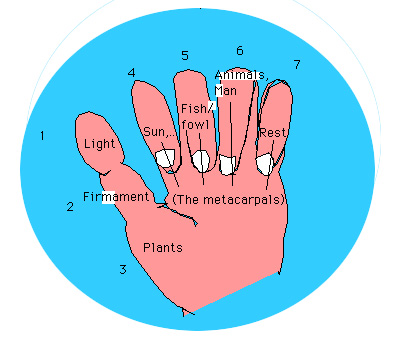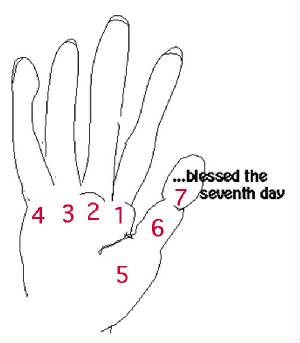|
Gen. 2:1 Thus the heavens and the earth were finished, and all
the works, (by Natural Laws), of them.
Gen. 2:2 And upon the Seventh day, (the Cenozoic Era of Geological Time), God, (The First Uncaused Cause), ended his
work of which he had made all living creatures; and he rested, (seemimgly), on this seventh day, (yom, in the Hebrew, meaning any unspecified period of time) from all its work which he had made.
Gen. 2:3 And God, (Reality), blessed
this seventh "day," (the present era of Civilization), (7), and sanctified it
(as The Sabbath): because that He had rested from all his work (which in the initial and absolute
energy transformation, had converted into matter, and had evolved as a micro-cosmos in the human mind).
Gen. 2:4 These are (the Seven Eras), the generations of the heavens and
of the earth when they were created, in the day that God, (in an initial Big Bang), created,
(or transformed the initial, absolute pre-existing energy into the material) earth and the heavens.
(click here for next page)
| (picture is link to more info |

|
| THE HAND AS A MEMORY AID |
|
|
 |
|
| The list of Mankind' Evolution! |

|
Beginning with Aaron, priestly status has been passed down through the ages, from fathers to sons through word of mouth.
To this day, all the Cohanim are seen as descendants of Aaron, not just figuratively but by blood. Many, but not all, have
the surname Cohen, Kohen, Cohn, Kohn, Cone, Kone, Cahn, Kahn or Kahane. (Cohan in Hebrew means priest.)
In Orthodox and some Conservative congregations, they are accorded special respect and are the only ones who can perform
certain important religious duties. The Cohanim Blessing is made by holding the hand with a split between the ring finger
and the middle finger- a gesture decidedly similar in posture to the greeting of Dr. Spock's hand on "Star Trek."
Nimoy also devised the Vulcan Salute consisting of a raised hand, palm forward with the fingers parted between the middle
and ring finger.
It is said to be based on the traditional kohanic blessing, which is performed with both hands, thumb to thumb in this
position; a position thought to represent the Hebrew letter shin ?. (This letter is often used as a symbol of God in Judaism,
as it is an abbreviation for God's name Shaddai.
This usage is seen, for example, on every mezuzah.
In Jewish cemetries, the hands spread as described, appear carved on gravestones of dead Cohan, Kofh, or similar derived
names from Kohan.
|
 |
|
|
|

